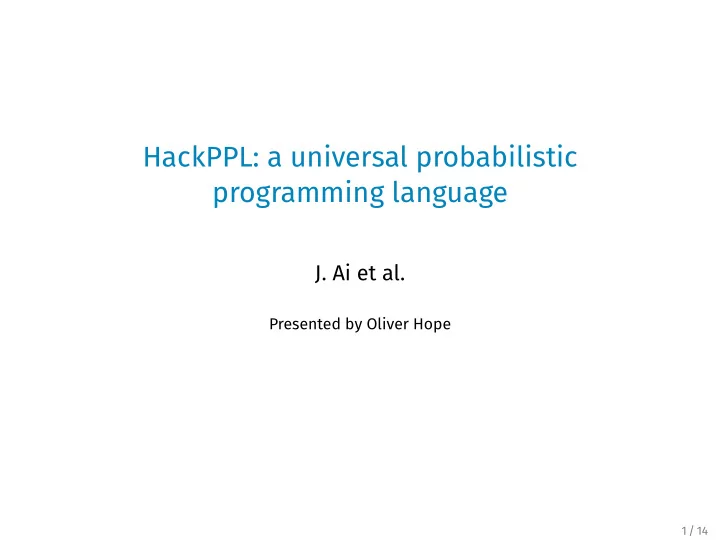

HackPPL: a universal probabilistic programming language J. Ai et al. Presented by Oliver Hope 1 / 14
Background PPLs are becoming more important Reduce development time for Bayesian Modelling PPLs trade off effjciency and expressivity Eg: DSLs: Stan[1], BUGS[2]; Embedded: Edward[3], Pyro[4] 2 / 14 P ( A | B ) = P ( B | A ) P ( A ) P ( B )
What is HackPPL An extension to Hack A Universal Probabilistic Programming Language Features: 3 / 14 ◮ Modelling ◮ Inference ◮ Assessment ◮ Mix with arbitrary Hack[5] code
Language Features: Coroutines Inference often uses Monte Carlo Algorithms Want to avoid unnecessary re-execution for selectively exploring sub-computations. “Models are implemented as coroutines that are reifjed as multi-shot continuations in inference code” fundamental characteristics: 1. Values persist between calls 2. Execution continues where left off are returning from suspension Uses state machines, CPS and Trampolining 4 / 14
Language Features: Coroutines 5 / 14
Language Features: Data models Continuous Values: Discrete Values: 6 / 14 ◮ Tensors for distributions, samples, and observations ◮ Imported to Hack from PyTorch[6] ◮ Natively support reverse-mode automatic differentiation ◮ Introduce DTensor ◮ Can convert to one-hot encoding ◮ When used, we run simulations for all values
Language Features: Distributions Many built in Must implement: Allow for batch sampling and scoring too. 7 / 14 ◮ sample(n) : retrieve n i.i.d samples from distribution ◮ score(x) : compute the log probability at x
Inference Engine Completely separate to modelling (for fmexibility) Aim: “Obtain a posterior estimate for model parameters” Takes a trace-based approach PPLInfer class: Built-ins such as Hamiltonian Monte Carlo 8 / 14 ◮ Centralised way to specify confjguration ◮ Centralised way to construct pipelines
Inference Engine Auto-tunes hyperparameters using No-U-Turn[7] (for HMC) Supports automatic marginalisation[1] for discrete parameter sampling This requires multi-shot coroutines Can resume inference from history Supports Black Box Variational Inference[8] (a form of scalable inference) 9 / 14 C � P ( y | p, µ, σ ) = p c Normal ( y | µ c , σ ) c =1
Assessment Simple to obtain the posterior predictive distribution. (effectively simulation mode) There is a playground built into Nuclide IDE A realtime visualisation library (Viz) A model criticism library for posterior predictive checks[9] 10 / 14 � P ( y new | y ) = P ( y new | θ ) P ( θ | y ) dy
Criticisms No comparison to existing PPLs No evaluation of performance No evaluation of UX Many statements lack justifjcation Code is incomplete for brevity — this is not stated though. Nuclide (and in fact HackPPL) is not available outside Facebook. 11 / 14
Questions? 12 / 14
References I ArXiv, vol. abs/1610.09787, 2016. [6] Pytorch. [Online]. Available: https://pytorch.org/ Available: https://hacklang.org/ [5] Hack · programming productivity without breaking things. [Online]. vol. 20, pp. 28:1–28:6, 2018. “Pyro: Deep universal probabilistic programming,” J. Mach. Learn. Res., T. Karaletsos, R. Singh, P. A. Szerlip, P. Horsfall, and N. D. Goodman, [4] E. Bingham, J. P. Chen, M. Jankowiak, F. Obermeyer, N. Pradhan, “Edward: A library for probabilistic modeling, inference, and criticism,” [1] B. Carpenter, A. Gelman, M. Hoffman, D. Lee, B. Goodrich, M. Betancourt, [3] D. Tran, A. Kucukelbir, A. B. Dieng, M. R. Rudolph, D. Liang, and D. M. Blei, for complex bayesian modelling,” 1994. [2] W. R. Gilks, A. Thomas, and D. J. Spiegelhalter, “A language and program https://www.jstatsoft.org/v076/i01 no. 1, pp. 1–32, 2017. [Online]. Available: programming language,” Journal of Statistical Software, Articles, vol. 76, M. Brubaker, J. Guo, P. Li, and A. Riddell, “Stan: A probabilistic 13 / 14
References II [7] M. D. Hoffman and A. Gelman, “The no-u-turn sampler: adaptively setting path lengths in hamiltonian monte carlo,” J. Mach. Learn. Res., vol. 15, pp. 1593–1623, 2011. [8] R. Ranganath, S. Gerrish, and D. M. Blei, “Black box variational inference,” in AISTATS, 2013. [9] A. Gelman, X.-L. Meng, and H. S. Stern, “Posterior predictive assessment of model fjtness via realized discrepancies,” 1996. 14 / 14
Recommend
More recommend